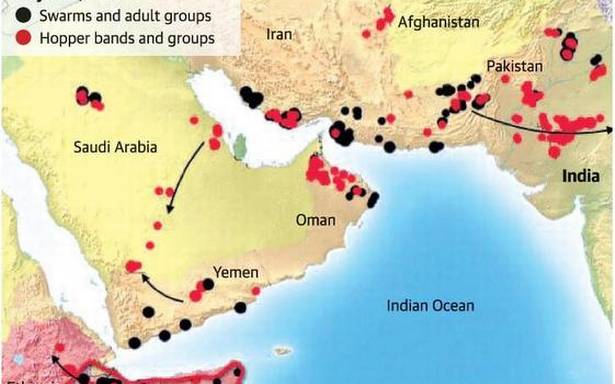The story so far: India is gearing up for what could be one of its worst locust invasions in decades. Outbreaks of the insect attack have been reported from Gujarat, Rajasthan, Maharashtra, Madhya Pradesh, Punjab, Haryana and Uttar Pradesh. On Thursday, May 28, the Delhi government issued an advisory to farmers to spray pesticides and keep a possible attack at bay. Last year, Gujarat and Rajasthan had reported infestations. But it could be worse this year because of a chain of climate events, administrative laxity in several countries and the difficult circumstances brought on by the COVID-19 pandemic. Experts have warned of huge crop losses if the swarms are not stopped by June when the monsoons will lead to a new season of sowing rice, sugarcane, cotton and other crops.
When was the last big outbreak?
The last big infestation was in 2010. There were 13 locust plagues between 1964 and 1997. From 1997 to 2010, there were five outbreaks that were controlled. From 2010 to 2018, there were no major swarms or breeding reported, according to the Locust Warning Organization (LWO), in Jodhpur. In 2019, Gujarat and Rajasthan reported a significant surge in locust infestations. Nearly 3.5 lakh hectares of cumin, rapeseed and mustard were damaged and officials had then said that it was the worst attack since 1993. This was partly due to an unusually long monsoon but also because pest-control operations were inadequate; therefore, nascent populations of the insect had not been wiped out.
Also read | Locust surge may turn into global plague: expert
Who keeps an eye on the locusts?
As a result of the 1926-1931/1932 locust plague, India, under the British Raj at the time, began research into the desert locust, beginning in 1931. It then led to the establishment, in 1939, of a permanent Locust Warning Organization (LWO), with a station in Karachi (undivided India). Its main job was to keep out an eye for a specific sub-species of the insect, the desert locust, that sprang into the region from the Thar desert. There is a wealth of scientific and newspaper reports th

